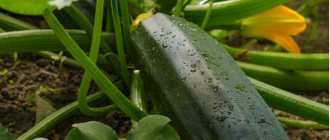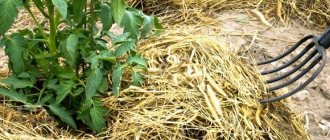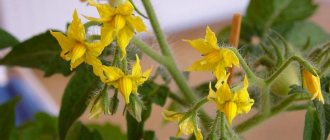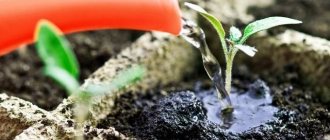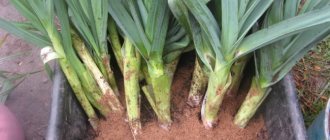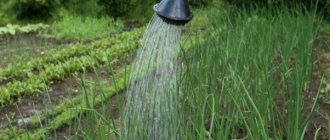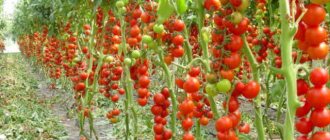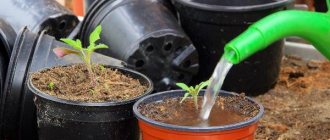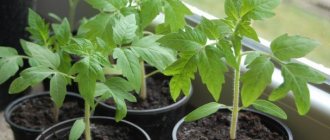How often to water tomato seedlings after germination and planting on the windowsill at home
Tomatoes are healthy vegetables that are grown in every household in our country. Experienced gardeners and newcomers to this business are trying to grow this product on their own. Most often, seedlings are used for this. To get a good harvest, it is necessary to take into account the climatic conditions of the region where the crop will grow.
In addition, you need to know how often to water tomato seedlings after germination, before and after picking, and how to do it correctly. There are certain recommendations, following which you can get a good and healthy harvest.
Frequency and rules of watering
If you decide to grow tomatoes through seedlings, then you need to properly organize irrigation
This issue must be approached with caution, because on the one hand, tomatoes love moisture, but on the other hand, its excess will also lead to their death, as will its deficiency
Advice!
Containers with drainage holes will help to avoid excess liquid in the soil.
The following recommendations will help you water your seedlings correctly:
- seeds are sown in moist soil, so there is no need for subsequent irrigation before the first shoots appear;
- Covering the container with seeds with film will help to avoid drying out the earthen coma;
- Start watering the plants 2-3 days after the seedlings “hatch”;
- further irrigate the plants as the soil dries out. To avoid damaging the sprouts, use a watering can with “rain”;
- tomatoes love water, but not humid air, so you need to make sure that moisture does not get on the leaves;
- Spraying should be avoided, as it may give the impression that all layers of the earth are evenly irrigated.
You can also dilute fertilizer in water once a month to nourish the young shoots.
What water is needed for irrigation
Tomatoes love warmth, so watering them has a number of features. For this procedure, the temperature of the liquid must be at least 20 degrees.
Advice!
It is best to use rainwater or melted snow for home seedlings. If there is no such liquid, then the usual one from the water supply will do, but it must be settled.
If you do not adhere to these rules, then seedlings may get blackleg from cold water. And unsettled liquid from the tap can ruin all your work.
Watering tomatoes after germination and picking
Novice gardeners who grow tomatoes at home do not know how to water them correctly. This manipulation is necessary both for good vegetable yields and for the health of the crop. And after the seeds have sprouted, you should start planting them.
To keep the stems strong, picking is required. This should be done after 3-4 leaves appear. A few days before transplanting, moisten the soil. This must be done so that the plants can be easily removed without damaging the roots.
Attention!
If you have carried out this procedure, then water the plants no earlier than 4-5 days after picking. Each container must have its own tray through which watering will be carried out. Thanks to this, the root system will be drawn to moisture, which will strengthen it.
After picking, it is necessary to water the tomato sprouts as soon as the soil dries out. But still do this no more than once a week.
The amount of liquid should be gradually increased depending on the growth of the crop. The most abundant watering should be before the plant is transplanted into open ground.
In this case, the soil in the container where the young plants are located must be moistened 2 hours before manipulating them.
The transplant is carried out in the evening. To do this, the young crop must be transferred along with the soil into previously prepared holes. If the seedlings grew on the windowsill in peat pots, then they need to be planted in them - in the future they can replace fertilizing the crop.
Plant tomatoes in soil that has been moistened in advance. After this, watering should be postponed for 14 days. This method will allow the plant to take root and protect the root system from being washed out.
When the tomatoes bloom, watering should be done every 5-6 days. For this you need to use only settled liquid at room temperature.
Watering after picking
About three days before the planned picking of tomatoes, the seedlings are watered at home. You should water the tomatoes very generously so that the soil mixture becomes deeply moistened.
After this, the seedlings are no longer watered from above. Is it possible to water through a tray? It is even necessary to water through a tray. This way you can force the roots of the sprouts to stretch deeper, which means they will become stronger and the plants will be able to develop a powerful root system.
After picking, the stronger tomatoes begin to be watered again at the root as the substrate dries. You need to use only settled warm water and try not to get it on the leaves when watering.
Subsequently, the tomatoes are watered in the usual way until they are planted in the ground as needed.
Folk remedies and tips for growing tomato seedlings
Opponents of industrial organics can choose what to water tomato seedlings with so that they grow strong from folk recipes. Among summer residents the following are actively used:
- infusion of onion peel kills pathogenic microflora, revitalizes and gives strength for growth;
- A 3.5% baking soda solution will make the fruits sweet;
- a weak iodine solution will help replace nitrogen fertilizers;
- nettle infusions as a source of trace elements and nitrogen;
- Garlic pulp diluted with water in a ratio of 1:50 will help get rid of white deposits on the soil.
Iodine for the garden
We are not talking about iodine in its pure form. The iodine solution is prepared in strict accordance with the proportions. An overdose is detrimental not only to plants, but also to the soil as a whole. Proper watering of tomato seedlings with iodine will give the bushes rapid growth and formation of ovaries. The stems become stronger, thicker, and the foliage acquires a bright green color. More flowers are formed in the fruit ovary, which means the yield increases.
Recipe for late blight: 15 drops of liquid iodine per 10 liters of water, diluted with 1 liter of whole milk. The solution is used to spray the entire bush at intervals of 2 weeks. Abundant wetting will help reduce the risk of late blight.
As a trace element, iodine is essential for the process of photosynthesis. Its deficiency in the temperate climate zone negatively affects plants. There must be a proper, precise dosage, since it is not recommended to frequently water tomato seedlings at home with this solution.
Live yeast for seedlings
On the grocery shelf there is another universal product - yeast. They can work wonders even in depleted soil conditions. Their composition is rich in amino acids, which help seedlings strengthen immunity and resistance to bacteria and fungi. Before picking, watering tomato seedlings with yeast gives strength for active growth. It is less susceptible to negative factors: scorching sun, lack of moisture, fungal infections.
- dry yeast 5 g;
- sugar 5 tsp;
- fine wood ash without impurities 1 tbsp;
- water 0.5 tbsp.
Mix all the ingredients, place in a warm place and wait for the yeast to react with the sugar. A “cap” should form, which indicates the readiness of the infusion. Dilute the resulting mixture with water in a ratio of 1:10.
Is it necessary to fertilize sprouted bushes, and is it possible to water tomato seedlings with yeast during the period of active growth? Yes, the mineral and amino acid composition acts as an antioxidant for maturing sprouts. Enriches the soil, creates favorable conditions for the formation of buds and ovaries. Yeast is used as an immunostimulant and growth activator. It is completely organic in origin, which guarantees an environmentally friendly harvest.
- large-fruited tomatoes during the growing season - 0.5 liters per m2 before planting in the ground;
- low-growing and small-fruited - 0.2 l per m2.
It is important to know when to use organic fertilizers in moderation, otherwise the seedlings may die. Watering for tomatoes is an important component of agricultural technology
A deficiency leads to drought, and an overdose leads to wetting and rotting of the roots. Compliance with water regime standards will help set the basis for a rich harvest at the first stage of growing tomatoes. See the article: Fertilizers for tomato and pepper seedlings
Watering for tomatoes is an important component of agricultural technology. A deficiency leads to drought, and an overdose leads to wetting and rotting of the roots. Compliance with water regime standards will help set the basis for a rich harvest at the first stage of growing tomatoes. See the article: Fertilizers for tomato and pepper seedlings.
Proper watering
Oddly enough, watering the tomato is very important. Therefore, it is undoubtedly important to figure out how often you should water the crop. After all, it is with water that the roots receive all the necessary nutrients.
This unique and tasty vegetable will develop well if the soil in which the crop is grown is 85-90% saturated with moisture. You can check this yourself using one of the simple methods: squeezing a lump of earth in your hand from a depth of 10 cm from the surface. If a lump has formed and disintegrates when pressed lightly, then the soil moisture is suitable. In other cases, you will have to clarify how often the seedlings need to be watered to achieve the optimal humidity level.
Water is a source of life. And not only for humans, but also for plants. And the “correct” watering of tomato seedlings is to maintain the volume of water and regularity in accordance with the periods of growth of future seedlings.
Watering seedlings
For those who grow seeds in a greenhouse, the first time to water the tomato seedlings is 2, or preferably 3 days after the seedlings sprout en masse. The soil will remind you to water - the top layer will begin to dry out by this time. The sprayer will serve as a good helper for those who are new to growing tomatoes in a greenhouse and for those who are afraid of “flooding” the newly emerged tender shoots. In this case, it is worth carrying out the procedure carefully so that practically no water gets on the plants.
Further watering of future tomatoes should be moderate and regular.
You should not allow the soil in the greenhouse to dry out, but you also do not need to flood it.
Organic fertilizers are added to the water for irrigation once a month.
Watering sprouts
Two days before the picking process, and this period determines the presence of the first 3-4 leaves, the seedlings must be watered one last time. Thus, at the time of picking, the soil will still be wet, but crumbly.
You cannot water the seedlings after picking for another 4-5 days. To get well-developed tomato seedlings with a strong root system, you need to transplant them into containers with trays for watering. This is explained by the fact that after picking, the roots will begin to stretch and get stronger in order to get moisture.
5 days after the picking, water the soil again and set a schedule according to which further watering would be carried out once every seven to ten days.
In general, the condition of the plants themselves and the soil will prompt watering if the top layer begins to dry out.
Abundant watering should be done before the date of planting tomato seedlings in open ground. This way you can transplant seedlings with minimal damage to the roots.
Watering seedlings in open areas
After planting in open ground, tomato seedlings need to be watered not very often, but quite abundantly. Poor, infrequent watering, which is done very often in abundance, has a bad effect on tomato seedlings. In the second case, the water will lower the temperature in the soil, and in the future this may affect fruit set.
Many people begin to water the seedlings abundantly immediately after planting. But, in reality, tomato seedlings do not require this. Firstly, before landing, it was watered abundantly. Secondly, this watering is enough for the tomato roots to take root well and take root in the soil.
In the future, the already rooted tomato seedlings are watered according to the following scheme:
- during the period of ovary emergence, the soil should be optimally moistened so that the plants receive sufficient moisture;
- from the beginning of flowering until the appearance of tomato fruits, the humidity level must be moderate;
- on hot sunny days, watering should be done in the early morning or about 2.5-2 hours before the sun sets;
- when it is cloudy outside, you can water tomato seedlings at any time.
Watering greenhouse seedlings
Seedlings in a greenhouse should also be watered with caution to prevent water from stagnating on the soil surface. The first watering should be done after the first shoots of tomatoes appear. The next procedure should be carried out when the seedlings are a little stronger, after about 2 weeks. In general, watering in the spring should not be excessive. It will be enough to moisten the soil once every 8-10 days. In the summer, watering in the greenhouse should be done quite often, for example, once every 5-7 days. One plant needs 2.3-3 liters of water.
Usually, for the convenience of watering, a barrel of water is placed in the greenhouse. However, its presence guarantees excessive evaporation. And tomato seedlings should be protected from high humidity. Therefore, the barrel should be covered with film or denser material.
Water for irrigation is taken at room temperature. The optimal water temperature is 18-22 degrees. There is no need to spray the seedlings.
It is worth trying to distribute the stream between the stems directly to the ground. After watering, you should wait until the soil is saturated with moisture and slightly loosen it. If the soil is dense and absorption is slow, it can be further accelerated using garden tools. For example, using a pitchfork, you can make several punctures between rows of tomatoes. After all the water has been absorbed, you need to briefly open the doors and windows in the greenhouse to ventilate it.
The seedlings should be watered for the last time approximately 2-2.5 weeks before harvest. The saturated roots will give moisture to the fruits. Accordingly, maturation will accelerate.
Watering in a mini-greenhouse
Tomato seedlings are often grown on window sills from seeds in a homemade greenhouse. But few people know that this is a troublesome process, since it is more difficult for seedlings to create normal humidity. To ensure good germination and get strong seedlings, you can use some tips from “experienced” gardeners:
- Additionally, place open containers with water near the mini-greenhouses so that the seedlings can be nourished with additional moisture;
- Before the first leaves form, you can lightly spray the tomato seedlings with water from a spray bottle.
Since planting seeds in mini-greenhouses usually occurs in February, when the heating season is in full swing, you can use another effective method - hanging a wet towel on the radiator under the windowsill with tomato seedlings. As moisture evaporates, it will create favorable conditions.
Features during different periods of growth
Conditions and features of water procedures vary depending on the stage of seedlings.
Seedlings before planting
When the first seedlings begin to grow, they still have an extremely weak root system. Irrigation is carried out through a fine spray bottle.
If you have 2-3 true tall leaves, you can use a watering can for watering
Water is poured carefully under the root, trying to prevent the splashes from touching the leaves and shoots.
A couple of days before picking, water well. After the procedure there is a 4-5 day break in watering. Excess moisture at this stage can delay rooting and adaptation.
After 5 days, they switch to the traditional regimen - once a week. Possible changes:
- in hot weather the interval is reduced to 3-4 days;
- in wet weather the period is extended to 7-10 days.
At the seedling stage in a greenhouse
For the transplant to be successful, young bushes are watered for several days in a row. This will help remove the plants from the pots with ease and without damaging the root system.
In greenhouse conditions, water in such a way as to maintain optimal humidity levels:
If the threshold values are violated, this will lead to overdrying or excess moisture and subsequent death of plants.
- Water in the morning, but not in the evening. This will avoid exceeding humidity levels and fungal infections.
- Ventilation is carried out to prevent the greenhouse effect.
- Mulch the beds with straw, hay, and sawdust.
Tomatoes
Tomatoes are rich in vitamins and minerals. Both adults and children enjoy eating them. According to research, this vegetable has a positive effect on the human body. Useful properties include:
Tomatoes are rich in vitamins and minerals
- A beneficial effect on the digestive system, since, due to their structure, tomatoes quickly break down and are over-poisoned. In addition, the acid content helps balance the acidity in the stomach. For gastritis, tomatoes exhibit healing functions.
- Pickled vegetables support intestinal microflora.
The most important effect of tomatoes on the human body remains their ability to counteract the formation of cancer. The vegetable contains three free radicals, which resist the attack. The most powerful of these is lycopene. What is most interesting is that processed products contain much more of this substance than fresh tomatoes. This is why experts recommend eating ketchup, sauce or pasta.
The culture is a plant that has a well-developed root system. The roots are able to grow and develop quickly. With the seedless method of growing the crop, the root system can go one meter deep. The roots can grow one and a half or two and a half meters in diameter.
On a note. If the soil is moist enough, roots can appear on any part of the stem; for this reason, the plant can reproduce by cuttings and side shoots. Roots on cuttings standing in a glass of water form on the second day.
The stem, depending on the variety, can grow from thirty centimeters to two meters in height. The leaves look somewhat like potato leaves. The plant blooms yellow, while the flowers are very small, collected in inflorescences. The culture is self-pollinating, since one flower contains both male and female organs.
The fruits are multi-locular berries that have different shapes and sizes. The fruits are colored pink, red, yellow, crimson and white. There are three types of bushes:
- non-standard,
- standard,
- potato.
When and how often to water pepper seedlings
You need to water pepper seedlings at home often, but little by little.
And very carefully, focusing on the condition of the soil, without trying to calculate how many times a week to moisten, or create a schedule:
- The lower the room temperature, the less often you need to water the pepper.
- If the seedling containers are placed on a windowsill, the soil on the side facing the glass remains moist longer.
- In cloudy weather, seedlings can be watered at any time of the day. When the sun is shining brightly, this is done early in the morning or at sunset, but not late in the evening.
- Seedling containers must have drainage holes to allow excess moisture to drain away. Otherwise, it may accumulate at the bottom, the root will begin to rot, while the top layer of the substrate will dry out. This happens especially often when planting peppers in containers that are too deep, or when making your own soil mixture.
Before germination
Pepper seeds are planted in moist soil and then generously sprayed with a spray bottle to ensure better contact with the substrate. Cover with glass or film. When ventilating the crops daily, condensation is removed.
As soon as water droplets stop forming, spray the soil again with a spray bottle. Before the seeds hatch, you only need to water the pepper this way, in the morning or in the evening - it doesn’t matter.
After germination
Before picking, seedlings are especially sensitive to soil moisture:
- if there is a shortage, it will quickly die;
- If you water the seedlings too much at least once, and do not take immediate action, the seedlings are likely to become infected with blackleg.
The frequency of watering after germination depends on the speed of drying of the substrate. It should always be slightly damp, but not wet. You need to moisten the soil often, but little by little. In a hot room, you may have to do this in the morning and evening.
After the pick
Peppers are planted in moist soil and watered, ensuring good adhesion of the root to the substrate. Then they cover it with film to retain moisture, and for several days after planting they only ventilate and collect condensation.
As soon as the plant begins to grow after picking, it begins to be watered little by little, but often, as the top layer of the substrate dries out. It is correct to loosen the soil in cups after each moistening - this way the moisture does not stagnate, the roots get enough air, and the likelihood of them rotting is minimized.
How to water pepper seedlings
Watering pepper seedlings is done only with warm water with a temperature of at least 20° C. This is not difficult to ensure at home.
If the region is ecologically clean, you can water it with melted snow. Well and tap water must be softened in one of the following ways:
- stand for 1-2 days in an open container to release the chlorine, drain from the sediment;
- add 3-4 g of citric acid per 10 liters of water;
- dissolve 1 tsp in 1 liter. with a pile of ash;
- 100 fresh peat per bucket of water;
- special preparations - hardness neutralizers, sold in flower shops.
It is best to use an ash solution for peppers - the crop is a big fan of potassium.
Some gardeners prefer to feed the crop with each watering after picking. This can be done, but the fertilizer should be diluted 5 times stronger than recommended for seedlings. In this case, planned fertilizing is canceled.
How to water seedlings against blackleg
It is very difficult to cure blackleg in seedlings, so it is necessary to carry out preventive measures to prevent seedlings from getting sick. If you detect the disease in a timely manner and take all measures to combat it, there is a chance to save most of the crop. Blackleg is treated with the following drugs:
- Phytosporin: added to the soil to disinfect it.
- A mixture of copper sulfate: used to treat the crop (0.4 g of the substance is diluted in 2 liters of water).
- Bordeaux mixture: seedlings are treated with the composition (20 g of product per 20 liters of water). If a small area of the trunk is affected, potassium permanganate, copper sulfate or colloidal sulfur will help get rid of the disease.
Traditional methods are also used to treat tomatoes:
- Copper sulfate and ash. 400 g of ash are combined with 2 teaspoons of vitriol. This mass is used to fertilize the surface of the earth around the stem.
- Onion peel. 500 g of husk is poured into 2.5 liters of warm water, the infusion is covered and left for a day. The finished solution is filtered and poured into a container with a spray bottle. The infusion is sprayed on seedlings and the surface of the soil.
- Potassium permanganate. The solution is used to disinfect soil and process tomatoes.
Note! If the disease is bacterial in nature, traditional methods do not work.
How to water seedlings in a greenhouse
After planting the plant in the greenhouse, it needs to be given some time to acclimatize.
To make this process easier, it is necessary to water the tomato bushes generously immediately after planting. During fruit set, the plant needs frequent watering. And when the fruits are forming, watering must be reduced, otherwise the tomatoes will be sour and watery.
Since tomatoes are watered frequently immediately after transplantation, the air humidity in the greenhouse remains at a fairly high level. This contributes to the development of late blight and the formation of sunburn on fruits and leaves.
To protect the plant from adverse effects, it is necessary to take some measures:
- Watering should be done early in the morning.
- It is necessary to make small furrows between the tomato bushes; when water gets into them, they will nourish the plant.
- To avoid unwanted erosion of the soil, the plant should be watered with a small stream of water.
- On sunny and hot days, after watering, it is recommended to ventilate the greenhouse well.
- To prevent leaf curling, watering during preparation for fruiting should be reduced to once a week.
The importance of proper plant irrigation
Tomatoes will develop well if you pay attention to the “correct” watering. They love moisture and will thank you with ripe fruits. It’s great if you mulch before watering the plants. To avoid inadvertently destroying young seedlings, carefully direct the water to the very center of the row spacing.
The consequences of improper watering after planting tomatoes can be very disastrous. So, if you give your plants a cold shower on a hot day, you risk causing shock to them. With very strong moisture, tomato roots are affected by harmful bacteria . And if you don’t water it enough, the flowers fall off and the small ovary falls off.
Rules for watering on the windowsill
As the tomato seedlings grow, the rules for watering them change somewhat. This depends on the growing season of the plant - at the very beginning it is recommended to avoid frequent watering, but as the seedlings grow, the number of waterings should be increased compared to the first.
Rules:
- Planting – To plant tomato seeds requires well-moistened soil. After they have been introduced into the soil, it is recommended to sprinkle them with a layer of dry earth on top. Watering is not carried out until the first shoots appear. It is better to place glass or film over the seedlings - these materials do not allow moisture to pass through, which means that the sprouts emerging from the seeds will have good conditions for growth.
- Watering the seedlings - the seedlings also do not yet require heavy watering - before planting the seeds, the soil already received a large amount of water, which means they still have enough moisture. Over time, watering is done as the soil dries out. During this growth period, seedlings must be watered very carefully, avoiding water getting on the leaves of young seedlings. Despite the fact that tomatoes are lovers of moisture, they are extremely sensitive to abundant watering. To avoid the negative effects of water on the plant, it is better to water the seedlings right up to the root. For these purposes, you can use a regular medical syringe - the stream will hit exactly the bottom of the stem, without damaging the fragile shoots;
- After picking, preparing the soil into which the seedlings will be transplanted comes down to abundant moisture, which must be done 1-2 days before picking. It is carried out when the seedlings already have 3-4 leaves. After picking, the seedlings do not require watering for about 4 to 5 days. Subsequently, the picked seedlings are watered by adding water to the trays of the containers - one abundant watering once a week is enough. This type of watering forces the roots to stretch downwards - towards the source of moisture, which is why they develop and grow, which strengthens the entire root system as a whole.
- Watering when the seedlings are planted in a permanent place - so that the root system of the seedlings does not disintegrate, and the earthen ball around it is preserved, there is a need to water it before planting. After planting in a permanent place, the tomato is not watered for about two weeks - only after this time, water is added generously (up to 10 liters per bush), no more than once a week. After planting, you must follow the same watering technique as when watering seedlings on the windowsill - apply water carefully, at the root. Then the tomatoes can be watered over the entire surface of the soil, including the row spacing. This type of watering is most favorable for tomatoes, since this type of plant has a spreading root system that quickly develops in the soil. But it is worth remembering that even if the seedlings seem to be stronger, you still need to water them, avoiding the leaves - such watering is not dangerous for a young plant and serves as a preventive measure for late blight.
The main mistakes gardeners make when watering
Many novice gardeners make mistakes when watering, which lead to tomato diseases and sometimes even their death. Such errors include:
- The most common mistake when sowing tomato seeds is taking containers without drainage holes. In this case, the ground becomes swamped when watering, since there is nowhere for excess moisture to escape;
- Using cold and unsettled water. Cold water causes blackleg to appear. Unsettled water contains harmful substances that also harm plants.
- Sprinkling. Plants should not be watered by sprinkling. Moisture falling on the leaves harms the plants causing burns and late blight. In addition, the roots of plants are washed out. This type of watering can be used during the initial development of sprouts and only using a spray bottle.
- Excess moisture. The amount of water for growing plants should be increased gradually. When there is too much moisture, plants begin to rot.
- Small amount of water and irregular watering. Lack of moisture also negatively affects plant development.
- Watering seedlings before diving. At the same time, plants are more difficult to tolerate transplantation.
- Watering the sprouts in the first 1-2 days after diving. This makes it more difficult for plants to take root.
- Drying the soil when transplanting into open ground or a greenhouse. In the absence of watering before transplanting, the roots of grown plants are damaged. But transshipment of an earthen clod is more difficult.
- Watering seedlings in the first days after planting.
- Incorrect calculation of the volume of water during plant growth and the formation of flowers and fruits. During different periods of tomato development, the amount of water varies, as does the frequency of watering.
By avoiding these mistakes, you can grow strong and healthy seedlings, and then get an excellent harvest.
How to water the seedlings to prevent them from stretching out
One of the reasons that seedlings weaken and stretch is excessive watering, so if the seedlings begin to stretch upward, the stems become thinner, and the leaves become pale, it is urgent to reduce the frequency and volume of watering and eliminate any fertilizing. By following simple watering rules, you will get strong, healthy seedlings, which means a bountiful harvest.
Watering for tomatoes is an important component of agricultural technology. A deficiency leads to drought, and an overdose leads to wetting and rotting of the roots. Compliance with water regime standards will help set the basis for a rich harvest at the first stage of growing tomatoes.
Watering for diseases
Tomatoes have many different diseases and pests, so it is necessary to take preventive measures. Otherwise, the risk of losing part of the harvest is quite high. Let's look at the most common diseases and how to water tomato seedlings when they occur.
The leaves of tomato bushes turn yellow
If the leaves of seedlings turn yellow, this may mean:
- the soil is waterlogged,
- its acidity is increased,
- lack of nutrients
- there was a fungus on the seeds.
In these cases, mineral fertilizers containing potassium, zinc and nitrogen are used 7 days after planting and repeated after 2 weeks.
For fungus on seeds, use a solution of potassium permanganate, in which they are soaked before sowing.
From late blight
To prevent late blight, tomato seedlings are dipped in a solution of Fitosporin before planting. Then spray with this drug when the ovaries appear and repeat this procedure 3 times a month.
It can also be added to water when watering every other time.
Tomato seedlings on the windowsill: growing rules
When it’s still winter outside, many gardeners have green tomato seedlings on the windowsill. In a couple of months, beautiful, strong bushes, on which flower buds are already beginning to appear, will be planted in open ground or in a film shelter. How to get seedlings that will become the basis of a productive bed?
First you need to choose the right seeds
If you buy them in a store, pay attention to expiration dates and storage conditions. It is advisable not to take expired ones, but if there is some kind of promotion at a retail outlet and the packaging is much cheaper, you can buy a few pieces and sow them for testing.
Often the germination rate of such seeds is low. Also, the packs should not show signs of damage or moisture. Storage at low temperatures sometimes has a positive effect on germination, of course, if it is short-term. Tomatoes, after all, are tropical plants by origin, and they are not supposed to withstand severe frosts.
Tomato seedlings on the windowsill sprout within 3-4 days, and after 10-14 days the first true leaf appears - which means it’s time to pluck. What is the point of this operation? First, sorting. Those bushes that have grown larger and more powerful are planted in one box, the rest - in another. The former will reach the size required for planting earlier, and the latter a little later. If the plot is small and a lot of seedlings have sprouted, it is better not to replant the weak ones, choose the one that is stronger, and spend energy on growing it. Also, when diving, the roots of tomatoes are damaged, and immediately after planting they begin to grow and branch vigorously, the plant becomes stronger and healthier. If the stems of the tomatoes are stretched out, replant them deeper, burying them right up to the foliage - new roots will grow on the entire trunk immersed in the soil.
Tomato seedlings on a windowsill are very sensitive to watering. It is advisable not to allow the soil in the box to dry out. Although slightly drooping bushes come to their senses within half an hour to an hour after watering, frequently bringing them to this state slows down the growth of seedlings.
Since you have to start growing tomatoes on a windowsill in winter, the lack of sunlight affects the seedlings. It stretches out, the distance between the leaves increases, and they themselves turn pale. This effect can be prevented using special chemical fertilizers like “Athleta” or in a more interesting way - stroking the sprouts. If you run your hand over the bushes several times a day, the seedlings will be more squat and stronger. And there is a scientific explanation for this: disturbed tomato leaves release ethylene gas into the air, the same gas that is used to ripen green tomatoes taken from the bush. It helps to slow down the growth of seedlings, and all the power of nutrients goes to strengthening the bush. The main thing is not to overdo it with affection. Plants are not cats, and you shouldn’t pet them more than 20 times a day.
Tomato seedlings on a windowsill, especially at the beginning of their development, are often adjacent to mold fungi, which thrive on the surface of warm and moist soil. It is not necessary to fight mold - it disappears on its own as soon as the tomato bushes grow a little. Until then, try not to over-moisten the substrate and ensure that the air humidity is reduced, for example, by ventilation, if, of course, the weather permits.
But not only seedlings can be grown in this way. Some also keep adult, fruiting tomatoes on the windowsill. Varieties with a low bush allow this method of maintenance. Of course, it is more labor-intensive, but for those who do not have land, this is the only opportunity to get their own harvest. Breeders have developed the following varieties for this purpose: Sadovaya Zhemchuzhina, Hummingbird, Little Prince, Florida Petit, Siberian Dwarf, etc. Indoor tomatoes need to create conditions that imitate natural ones. For example, periodically make rain from a spray bottle, and also tap the stem during flowering - daily, in the middle of the day - to increase the number of ovaries on the bushes.
fb.ru
FAQ
You can often hear the question: “How to grow tomatoes on a windowsill?” Answers to this and other questions can be found in this section.
Olga writes : “Good afternoon! I'm thinking about growing tomatoes in a pot this year. I’ve even already bought “Balcony Miracle” seeds. I read the article and thought, is it necessary to fertilize plants in order to get a harvest? Are Growth and Agrolife harmful to health?
Answer : “Tomatoes need a large number of useful elements for normal development and growth. All this plant can only take in the ground. When growing vegetables in pots, their feeding area is limited due to the size of the container. It turns out that the amount of useful and necessary microelements is also limited. That is why it is our responsibility to provide the plant with all the necessary microelements.
The basic principle of fertilizer is to adhere to the recommended dosage specified by the manufacturer and not increase it. It is then that the minimum amount of fertilizer applied will have a positive effect on the plant. In the case when the recommended dose of fertilizing is violated, this leads to the accumulation of unnecessary substances in the fruits.”
Tamara writes : “I figured out how to grow tomatoes on the windowsill. But I got a large number of seedlings. Maybe plant some of it near the entrance of a multi-story building? Will they be able to grow up? What size pots are best for growing vegetables indoors? At the moment I have them growing in half-liter plastic cups. By the way, flowers will be released soon. Can you plant 2-3 in one container?”
Answer : “Tomato seedlings can be grown both in the garden and in the flower garden. The only condition: it is necessary that the sun hits the plants at least 3-4 hours a day.
For growing on a balcony:
- one seedling is planted in a 3–4 liter container;
- two seedlings are planted in a 5–6 liter pot;
- three seedlings are planted in a 10 liter pot.
If you plant more densely, the seedlings will not have enough nutrients, and this is the main reason for a poor harvest.”
Inna writes : “Two types of tomatoes grow in my apartment. One of them even has green fruits already appearing on it. But, unfortunately, two bushes began to fade. All the branches of the plants are drooping and the leaves hang like shreds. And these bushes have the most ovaries! I water regularly; I moved the plant to the shade, since it is unbearable in the sun. In the evenings I spray them and fertilize them with Rost. Tell me, why is this? Maybe I flooded them?
Answer : “Excessive watering of an adult plant in hot weather is not dangerous. The reason that the bushes wither may be overheating. Since rhizomes in a pot overheat much faster than in the garden. I would recommend shading the pots from direct sunlight in hot weather. For these purposes, you can use regular cardboard. It's great that you moved the potted plants into the shade. Try watering them several times during the evening. If in the morning the leaves become elastic, then there is nothing to fear, but if by morning the leaves still hang like “rags,” then most likely the root system has “cooked.” To help the plant, half of the ovaries and flowers must be removed.”
Gregory writes : “This time I decided to try growing tomatoes indoors. I planted the seedlings somewhere in mid-May. By mid-July they had already turned into bushes of impressive size. But flowering never came. This is fine? How long should I wait for flowering or do I need to stimulate the plant?”
Answer : “Don't worry. Over time, your tomatoes will begin to bloom. Maybe you planted mid-season or late-ripening varieties. Seedlings planted in May can bloom in early August. If you want, then stimulate.”
How often to water tomato seedlings?
Watering for tomatoes is necessary, since nutrients can only reach the plant with water.
Therefore, it is very important to figure out how to water tomatoes correctly? In order for this vegetable to develop normally, it is necessary to maintain soil moisture within 85-90%
To check the moisture, you can take a handful of soil from a depth of about 10 cm and squeeze it into a ball. If you get a lump and easily disintegrate when pressed, then this is the required soil moisture for growing tomatoes.
In order for this vegetable to develop normally, it is necessary to maintain soil moisture within 85-90%. To check the moisture, you can take a handful of soil from a depth of about 10 cm and squeeze it into a ball. If you get a lump and when pressed it easily disintegrates, then this is the necessary soil moisture for growing tomatoes.
Until the first true leaf appears, the supply of moisture in the soil must be constant. Therefore, it is best to place the boxes with tomato seedlings in trays and add water there as needed. It is best to water the seedlings in the morning with warm, settled water. Watering with snow or rain water is very useful. As an option, you can water it after defrosting the ice from the refrigerator. Water the tomato seedlings with so-called “living” water, which is prepared in a special way. Water is poured into the pan after the ice has melted, heated until hot (until steam appears), covered with a lid and quickly cooled under running cold water to a temperature of approximately 25°C. Now you can water your seedlings.
How to water tomatoes after picking?
After the first true leaf appears on the tomato seedlings, it is picked, that is, transplanted into a larger container. When picking, you should try to replant the plant with a lump of earth and not damage the small roots of the seedling. The transplanted seedlings are watered into a tray and placed in a place shaded from direct sunlight.
Tomatoes need to be watered rarely, but abundantly. Otherwise, with frequent but scanty watering, the tomatoes will develop poorly. Excessive watering can lower soil temperature, which will adversely affect fruit set. Therefore, the optimal option for watering a tomato is: quite generously once or twice a week, avoiding flooding. Moreover, watering also depends on the phase of plant development. As a rule, tomato seedlings need to be watered frequently after planting. At the time when the fruits are set, the soil should also be sufficiently moist. But during the period from flowering to setting tomatoes, as well as during their ripening, the soil moisture can be moderate.
The method of watering this vegetable is also important. Avoid getting water on the stems, leaves or fruits. You need to pour water at the root of the plant or into the furrows made between the rows of tomatoes. Such watering will moisten the soil without increasing air humidity. When watering with rain, drops of water remaining on the leaves can cause leaf burns and even contribute to the formation of late blight. But watering at the root must be very careful so that the stream of water does not wash away the soil and expose the roots of the tomato.
In hot summer weather, the best time to water is early in the morning or about two hours before sunset. At this time, the water will not evaporate immediately under the scorching rays of the sun, but will gradually be absorbed into the soil. In cloudy weather, you can water at any time of the day. And after watering, it is advisable to mulch the ground under the tomato bushes. To do this, you can use a special film, straw or compost. There is no need to loosen the soil after watering.
Now you know how to water tomato seedlings, now let’s find out why seedlings are sprayed with copper sulfate? Before planting seedlings in open ground, in order to prevent infection with fungal diseases, you should spray the tomato seedlings with a solution of copper sulfate. To prepare it, you need to dissolve 5 grams of copper sulfate in 3 liters of hot water and use this solution for spraying.
By properly watering tomato seedlings, you will get an excellent harvest of these healthy and tasty vegetables.
womanadvice.ru
How to determine the need for watering
Watering is carried out as the soil dries. However, not all gardeners can determine from the top layer of soil in containers with seedlings how often they need to be watered. To do this, you need to know how to determine soil dryness:
- Dry soil is dimmer than wet soil. If the soil turns gray, it needs to be watered.
- The soil moisture at the bottom of the pot is checked with a wooden skewer or toothpick.
- You can also use a 30 cm long metal wire with a bent hook at one end. It is carefully immersed in the ground near the wall of the container and pulled back out. If the soil sticks to the hook, then there is no need to water the tomatoes yet.
- You can dig up a lump of earth from a depth of 10 cm and form a ball. If sufficiently moistened, it will stick together. In this case, the ball should crumble when broken. If it does not crumble, the soil is waterlogged and watering should be postponed.
- A pot with dry soil weighs less than one with wet soil.
- Humidity can be calculated by the sound of the pot when it is knocked with a stick. A loud sound is produced by dry soil, while a dull sound is produced by wet soil.
Advice! You can maintain soil moisture for a long time if you mulch the soil near tomato bushes with sawdust or straw.
Watering tomato seedlings
Folk fertilizers are not inferior in efficiency to industrial fertilizers, but at the same time they cost almost nothing. Recipes inherited by summer residents from previous generations pass from mouth to mouth and help to grow strong and healthy seedlings.
Iodine
Experts have not thoroughly studied the effect of iodine on the plant, but the positive effect of using such fertilizing has long been confirmed experimentally. The element does not directly affect the growth processes of tomatoes, but is a catalyst for the absorption of nutrients and helps strengthen the immune system. In the case of seedlings, iodine is used only until the ovaries appear. After its influence, plants develop better, get sick less, and subsequently produce a bountiful harvest.
It is important to follow the correct dosage of iodine fertilizer. In large quantities the substance has a toxic effect on plants
It is recommended to water the seedlings with water with the addition of iodine 7 days after the first fertilizing with mineral complex fertilizer. To prepare the solution, 1 drop of iodine is dissolved in 3 liters of water. You need to water the seedlings with this product through a strainer, irrigating the leaves and the top layer of soil.
On a note! Before planting the seedlings in a permanent place, the soil is watered with an iodine solution prepared in the same proportion as for watering the seedlings. This will disinfect the soil and help the plants take root better. This manipulation should be carried out a day before the transplant.
Yeast
Yeast contains a lot of substances beneficial to plants and additionally improves the soil structure after application. Under the influence of the yeast solution, the growth rate of tomatoes increases, disease resistance improves, and productivity increases.
This fertilizing can be used at any stage of crop cultivation, but it is better to start doing this at the seedling stage. Yeast has an equally good effect on the development of the above-ground and underground parts of seedlings, helping them become stronger and recover faster after picking. Yeast does not cause any harm to the soil and plants, so you can safely use it.
To prepare the solution, use 50 g of fresh yeast or 5 g of dry yeast per 5 liters of water. Additionally, you can add 1 tbsp. spoon of sugar. All ingredients must be mixed and the mixture allowed to brew for 2-3 hours. Before use, the fertilizer is diluted in a ratio of 1:5.
Hydrogen peroxide
Hydrogen peroxide is used to stimulate the growth of tomato seedlings and prevent diseases. The product disinfects the soil well and prevents the proliferation of pathogenic microorganisms in it. Peroxide, as peroxide is also called, helps fill the roots with oxygen and neutralizes nitrates contained in the soil.
After watering with peroxide, iron and manganese salts that are useful for tomatoes are restored in the soil. The first feeding is carried out 2-3 weeks after emergence. In the future, the plants are watered with the product once a week. To prepare the fertilizer, mix 1 tbsp. spoon of hydrogen peroxide with 1 liter of water. The composition must be prepared immediately before use; it cannot be stored.
Feeding tomato seedlings during watering
Seedlings definitely need nutrients for proper growth and rapid development. To do this, watering young plants is combined with fertilizing. Nitrogen is especially important for seedling development.
It is on this substance that the following depend:
- stem thickness;
- saturation of foliage color;
- its juiciness.
A lack of nitrogen will lead to thinning of the seedlings - they will become pale and very weak.
Phosphorus is also important, which gives tomatoes energy to grow, promotes flowering and fruit formation.
But you cannot overdo it with adding nutrients, even if the seedlings are fed with folk remedies that are harmless. An excess can lead to the death of seedlings.
How many times should you feed tomato and pepper seedlings:
- The first time feeding is added to the tomatoes after the appearance of 3 true leaves.
- The second fertilizing is applied after picking, two weeks after applying the first fertilizer.
- Before planting seedlings in open ground, it is necessary to feed the plants again 10 days before the planned date.
For the first time, the seedlings should be fertilized with complex fertilizers that contain a lot of nitrogen. You can prepare the nutritional mixture yourself by mixing:
- 5 g potassium salt;
- 0.5 g urea;
- 4 g superphosphate.
All components are stirred and dissolved in 1 liter of water. The second time the seedlings are fed only with urea.
Along with tomatoes, many gardeners grow pepper seedlings. Pepper seedlings need to be fertilized with complex fertilizers. They should contain a lot of nitrogen for the strength of the stem, as well as phosphorus for the root system. After planting in the ground, it is enough to add complex mineral fertilizer to the bushes.
There are foliar feeding of seedlings and root feeding. Root fertilizers are applied directly under the root. The second is sprayed onto the leaves. For the first time, seedlings are added only to the root so that the root system develops faster.
Gardeners often use manure to keep seedlings strong. In this case, a bucket of manure is dissolved in 3 buckets of water. When the composition sits for a day, each bush is watered with it. Fertilizing with yeast also gives good results.
Tomato varieties for indoor growing
When choosing a tomato variety to grow on a windowsill, you should give preference to low-growing, early-ripening and productive varieties due to limited space. They won’t take up much space and at the same time will delight you with delicious fruits in early spring. Some of the most popular varieties are the following tomatoes:
- Balcony miracle. The height of a dense, even bush is no more than 60 cm. Small, round, bright red and sweet tomatoes ripen 90 days after sowing. The weight of one tomato is no more than 60 g. From one such dwarf you can take up to 2 kg of fruit.
- Oak. The variety is not a hybrid, early ripening, weakly branched, with a bush height of 40 to 60 cm. Round tomatoes weighing up to 100 g ripen at the same time, the flesh is fleshy, with a slight sourness. Requires artificial pollination when grown indoors, but has high resistance to late blight.
- Ruby Ed. The variety was created specifically for growing on window sills, balconies and terraces. The bushes are compact, up to 50 cm in height. Small fruits weighing from 20 to 50 g have a sweet taste and rich red color.
- White filling. Bushes up to 70 cm high grow equally well both in open ground and in a pot. The fruits ripen in 85 days; they are quite large (up to 130 g), round in shape, red in color with a slight white tint. The pulp is juicy, with sourness, the skin is dense.
- Little Red Riding Hood. A high-yielding variety up to 70 cm high with thick stems. Red-orange fruits weigh 70 g, the pulp is juicy, sweet and sour.
- Leopold. An ultra-ripe variety, 70 cm high. The fruits are matte red, weighing about 100 g.
And in order to have fresh vegetables not only in the spring, but also until the New Year, you can plant taller (up to 1 m in height) hybrid varieties of cherry tomatoes. On the windowsill they will take up more space and will require shaping and gartering, but they will bear fruit before the onset of winter.
Some of the new but already popular hybrids are the following cherry varieties: Ira F1, Lisa F1, Maksik F1, Lykopa F1. Small but very tasty red or yellow tomatoes grow in whole clusters and ripen quickly.
It is better to take pots of cherry tomatoes outside or onto the balcony for the summer, not forgetting to take them indoors when it gets colder.
Growing tomatoes on a windowsill is a fun activity that will not only help you while away the long winter days, but will also provide your diet with vitamins. Plant and eat for good health!
Soil selection
Particular attention should be paid to the substrate for growing tomatoes on the windowsill. It should be loose, nutritious and neutral acidity. The easiest way is to go to the same store where you bought the seeds and purchase ready-made special soil mixtures for tomato seedlings. This will be especially true for winter sowing; besides, store-bought soil already contains all the necessary nutrients, and there is no need to add additional components.
If you have the desire and opportunity, you can prepare the soil for growing tomatoes on the windowsill yourself by choosing one of the proposed mixture options, namely:
- 1 share of sand and 2 shares of garden soil;
- humus, peat and turf soil in equal parts;
- 1 share of vermiculite, as well as 4 shares of turf soil and compost.
Before use, soil from a garden or vegetable garden must be disinfected by dousing it with boiling water or calcining it in the oven.
